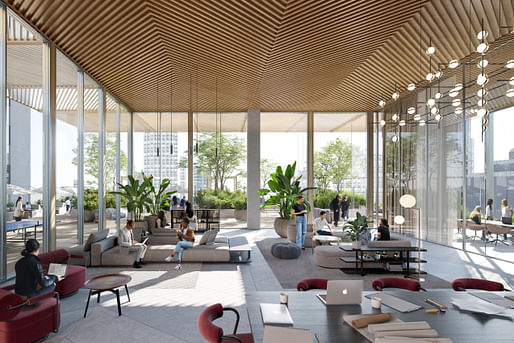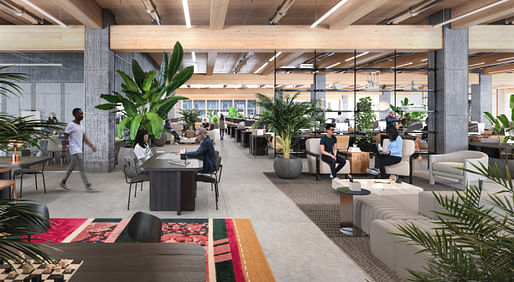
KPF has released details of the studio’s first mass timber tower, situated in Vancouver, Canada. At 16 stories tall, the Burrard Exchange tower is expected to be one of the tallest hybrid mass timber buildings in North America, providing 450,000 square feet of office and retail space within the Bentall Centre campus. KPF have served as the design architect for the scheme, while the Vancouver office of Adamson Associates Architects are serving as the architect of record.
The project will be built on one of the last large development sites in Vancouver’s urban core, currently occupied by a multistorey car park. The conversion of the site into retail and office space forms part of a reactivation of the 1.5 million-square-foot Bentall Centre, a major office complex in Vancouver’s financial district which also houses an underground shopping mall.

The tower’s hybrid, exposed mass timber structure will enclose office floor plates each measuring 30,000 square feet, set at 14.5-foot floor-to-floor heights to strengthen access to natural light. Terraces and loggias have also been designed on half of the tower’s 16 floors, while a rooftop deck provides tenant outdoor seating, meeting spaces, and a conference area. At street level, a lobby connects to below-grade shops at the Bentall Centre, while an at-grade pavilion anchors a new 20,000-square-foot plaza, forming one of downtown Vancouver’s largest outdoor gathering places.
“Burrard Exchange is a modern, loft-like structure with healthy, light-filled workspaces,” said KPF in a statement. “KPF’s innovative design utilizes mass timber, typically reserved for low-rise structures, to create a state-of-the-art green office tower, reducing the building’s embodied carbon. The mass timber is also a key design feature, intended to be unencapsulated and visible, highlighting and celebrating the project’s sustainable aspirations.”

With plans recently submitted to the city of Vancouver, the project is expected to begin construction in 2023. Upon completion, building operations for the tower will be 100% carbon neutral, according to the building’s operator, Hudson Pacific Properties.
The project joins other recent advances in mass timber construction across North America. Earlier this month, LMN Architects celebrated the topping out of the mass timber Foster School of Business Founders Hall at the University of Washington, while SOM completed a mass timber pavilion for the Chicago Architecture Biennial.
In July, LEVER Architecture unveiled designs for a new mass timber structure in LA’s Chinatown, while one month previous, Yazdani Studio unveiled a sustainability research center at Caltech, also constructed from mass timber. For those interested in learning more about mass timber construction, the CTBUH maintains an online resource hub dedicated to the material, through publications, videos, and a podcast.
24 Comments
Thuja Occidentalis mass timber should be printed with manufacturing technology developed off of the understanding of Bioengineering from Purell; it will store carbon and equip a manufacturing plant for bioengineering flowers and seeds into replacement forests to allow forest growth to catch up. We currently have a deficit of 25 Mha (Million Hectares).
(1) Global Forest Watch (2020). GLOBAL PRIMARY FOREST LOSS. Retrieved on December 6th, 2020 from https://www.globalforestwatch....
Now I've seen it all. Building a timber skyscraper in order to burnish its sustainability cred.
Bioengineered forests are not forests; they are timber farms.
Just say no to GMO.
This thing is also a great example of recycling: KPF is re-using the 1950's 2nd & 3rd rate NYC glass box design style.
I suppose a lot of KPF's employee energy was saved by taking this approach.
Having done a small bit of investigation into mass timber framing, given where we are in the development of the material & our evolving understanding of the structural system, this sort of massing & structure is almost inevitable. It's efficient, and from an Architectural standpoint there's a material honesty here that I personally appreciate.
It's easy to criticize while offering nothing substantive in response, but when you look at the decisions that go into designs like these, KPFs design is relatively nice. Assuming no option exists where this development doesn't get built at all, the option presented is close to if not the best case.
Y'all are mighty cynical.
Seconded
I don't know much about the BC building code but I do know Vancouver has it's own variation and it can be a bitch to navigate... specially with entirely novel building construction. Besides that, the simple and box gives a much better street feel than most of downtown Vancouver anyways.
This is not the most exciting application of the technology but it is not bad by any means. There is a pretty big question mark around the basic concept though, as far as how much of an impact this method will have and even if it is feasible to switch to this kind of construction at scale.
We are working on a mid-rise project in Europe currently that was to be mass timber, and were forced to abandon it as a result of cost and questions about supply chains. That is probably a temporary blip brought about by the broken supply chain created by covid. BUT, the question about viability remains. This article by Blaine Brownell gets to the point pretty quick, as does the source he builds his article on. There is a problem with global supply and demand at scale that suggests mass timber is pretty far from being a silver bullet.
Its still pretty cool and worth doing. But the upshot seems to be we are going to need even more radical approaches if we are going to cut carbon emissions from the building cycle.
My firm has been trying to get a Mass Timber project off the ground for years, and the issues you mention have hampered every single one. Add in the present supply chain & possible inflation uncertainties, and the numbers are going to be very, very difficult. I think we're going to see a lot more one-off projects where a higher budget can be justified. Over time as the industry learns, costs will drop enough that mass timber can compete with more traditional construction types, but that's a while off still.
The unfortunate reality is that it all comes down to cost. At the moment, the way these projects pencil is that the premium in material is offset by a huge gain in schedule. And even that just barely makes it work, which is why you only see extremely simple structures like this one.
Wood is pretty much the ultimate renewable resource. But when forest loss is over 25 million hectacres annually, a massive shift to timber construction replays the history of Rapa Nui od a global scsle. In fact simply continuing on the current path is suicidal.
resource shortage isn't the problem for society, except maybe fresh water. resource surplus in coal and oil is the bigger problem. where deforestation is happening it's to get access to the land underneath - for the most part the wood is just burned off uselessly.
https://www.bloomberg.com/graphics/2018-us-land-use/?sref=H6ddn91U really fascinating to see how large the amount of land used for timber farming already is. and how small "food we eat" is compared to many other things.
this green sustainable biophilic wellness shit is really sickening. really makes me want to pick up smoking again.
Yeah fuck the environment, right
I’ll take the gmo watermelon. It’s not the gmo that’s bad, it’s the gmo pesticides and herbicide relationship designed to maximize profit. This is not an issue with trees.
I believe that with gene editing technology we will be able to grow better timber, possibly super nutrition dense crops, drought tolerant crops, and novel materials that may be able to replace plastics…I’m very optimistic about the future of bioengineering.
i put anti-gmo people in the same category as anti-vaxxers, people who just out of hand reject science as a technique for improving life.
X... your "now" image is incorrect since it still has nasty black seeds. Please revise and resubmit.
we have started getting yellow seedless watermelons recently, very sweet but a little less juicy. i prefer the slightly grassy-taste soaking wet pink ones.
Non, Have you ever seen the original natural ancestor of a watermelon? It’s weird and tiny.
Midlander beat me to it, but I also consider anti-GMO to be the left corrolary to anti-vaxxers. It displays an embarrassing lack of knowledge about the technology plus an absurd purist view of what "natural" is.
i feel like some of the debate on the potential environmental benefits vs harms of mass timber construction are very narrowly focused and ignore the enormous volume of construction in n. america that is already wood-based.
the partial adoption of wood for structural use in high rise buildings is an incremental change, and will have far less impact than directly reducing emissions in materials production.
i think as architects we are biased to the impact on what we see in our own work. but foundations, roadways, highways, railways, subways, industrial buildings, sewer systems, water supply, and power supply are going to continue being built of concrete and steel and i suspect add up to far more usage of materials than the towers and boxes which constitute our share of the built environment.
It's a lot easier to do something about your own work though.
So interesting looking at the evolution of food from natural origins to today.
Block this user
Are you sure you want to block this user and hide all related comments throughout the site?
Archinect
This is your first comment on Archinect. Your comment will be visible once approved.